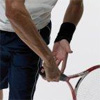- • “First I show the student how to hit the ball and point out what must be looked out for. In this way I avoid overloading the student with too much theory, which would be pointless – try learning to speak a language by only studying its grammar. Then I let my students execute the stroke in their own way as well as possible. As soon as the stroke is, in my view, technically acceptable, I begin with the actual training.”
An unorthodox, deeply ingrained stroke
 In the case of advanced players, one often finds that a stroke is executed in an unorthodox manner. In most cases, Michel will not attempt to change such a deeply ingrained stroke.
In the case of advanced players, one often finds that a stroke is executed in an unorthodox manner. In most cases, Michel will not attempt to change such a deeply ingrained stroke.
Practice has shown that this is often not feasible. It is more useful to solidify and sharpen such a stroke.
After all, we are all built differently. One person has long arms, the other is of short stature. That’s why Michel allows his students some freedom in their pattern of movement, as long as they comply with the basic principles.
- In line with the practice makes perfect principle, Michael has his students, as already mentioned, hit as many balls as possible during the hour of training. That’s why he hits the balls at a fast rate to his students, who attempt to return them properly. This is the procedure he follows in both private and group lessons.
As his students improve, he increases the tempo and/or hits more difficult balls. “If it appears that I have gone too far, I drop the pace back a little. In so doing, I am constantly paying attention to correcting possible mistakes in a stroke.”
Only at a later stage does Michel teach his students more complicated strokes, like the topspin-service, the backhand topspin-drive, etc. “But first they must reasonably master the basic strokes, so that they can rally with each other and thus get more pleasure out of their tennis.”


 Resumé(PDF)
Resumé(PDF)